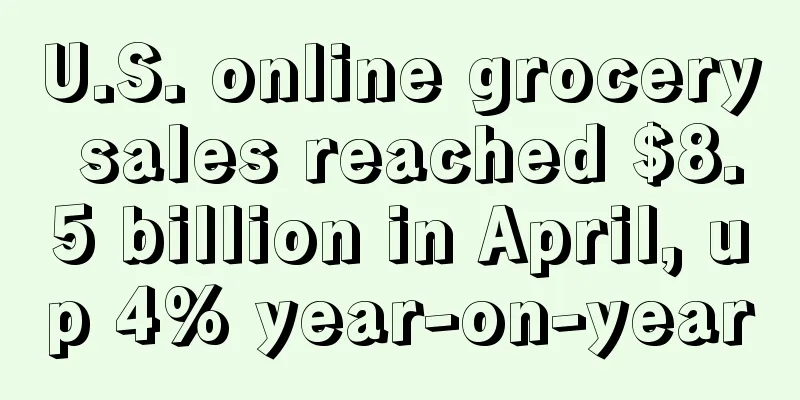U.S. online grocery sales reached $8.5 billion in April, up 4% year-on-year

|
It is learned that on May 14, according to foreign media reports, driven by growth in the delivery field, US online grocery sales increased to US$8.5 billion in April, a year-on-year increase of 4%. According to the latest Brick Meets Click and Mercatus Grocery Shopper Survey, U.S. grocery order frequency declined compared to a year ago as overall penetration remained stable. As a result, sales growth in April was driven primarily by home delivery. Data shows that self-collection sales (customers pick up orders at a designated location) increased by 2.1% year-on-year in April, with average order value (AOV) climbing. The growth was due to the decrease in monthly active users of the service (mainly people over 60 years old) and the decline in order frequency, which was due to the overall higher consumption level. Delivery sales (orders delivered by first-party, third-party vendors or retailer employees) climbed 4.3% in April. The growth in sales was driven by the expansion of monthly active users of the service, as major retailers launched subscription plans and increased penetration among users of all ages. Compared with April 2023, order volume increased, while AOV remained essentially unchanged. Meanwhile, home delivery sales grew 10.2% year-over-year, accounting for 18.7% of online grocery sales, driven by a modest expansion in its monthly active user base. However, a decline in order frequency for home delivery services led to an overall decrease in order volume. Currently, more and more online customers are starting to buy groceries from large retailers. In April 2024, orders provided by large retailers accounted for 51% of the online grocery monthly active user base, an increase of 500 basis points year-on-year. In contrast, in April 2024, orders from supermarket retailers accounted for only 30%, a decrease of 280 basis points year-on-year. Mercatus Chief Growth Officer Mark Fairhurst said that given the shift in consumer purchasing patterns, especially changes in shopping activities between supermarkets and large retailers, grocers need to improve the online and in-store shopping experience through technology investments. Currently, large retailers such as Walmart and Target have invested heavily in their applications, using emerging technologies such as artificial intelligence to enhance their ability to predict and adapt to customer behavior in real time. Author ✎Rayna/ Statement: This article is copyrighted and may not be reproduced without permission. If you need authorization, please contact: happy |
<<: Newegg launches new online store for college students
Recommend
What is FindNiche? FindNiche Review
FindNiche is a powerful niche analysis tool and a ...
The Middle East "Taobao" collapsed and became inaccessible, suspected to be closed!
So surprised! JollyChic, known as the Taobao of th...
Amazon's restocking volume plummets! How is the government making money?
A very abnormal situation suddenly appeared in th...
What is Cheki? Cheki Review
Cheki Zambia is the official store of Cheki, an Af...
The Thirty-Six Strategies for Going Global: A Competition of Cross-Border E-Commerce Models, Who is the Profit King?
The internal competition of the platform has inten...
The second trial also came to "visit relatives"? A large number of sellers' accounts were suspended during the Spring Festival!
Hello, all cross-border sellers Time flies The Spr...
What is BluePay? BluePay Review
BluePay is an Internet company dedicated to changi...
Amazon's high-paying operations will use the buried keyword method
A friend asked how to correctly embed keywords whe...
1.341 billion! How long will it take for sellers to earn as much as Wei Ya’s fine?
Recently, there has been constant news and gossip ...
In the US, Walmart surpassed Amazon and ranked second in the shopping app market in April
According to a report by , based on the shopping a...
Recommended collection! "Dangerous goods" in Amazon categories
text Amazon's official definition of dangerou...
What is European Cup Testing Technology Service (Dongguan) Co., Ltd.? European Cup Testing Technology Service (Dongguan) Co., Ltd. Review
CPST Testing Technology Services (Dongguan) Co., L...
Amazon starts pushing low-price entry, is it lower than Pinxixi?
Amazon’s “Low Price Store” is finally online , wit...
What is Zhihui Chuangxiang? Zhihui Chuangxiang Review
Shenzhen Zhihui Chuangxiang Technology Co., Ltd. i...
China's diplomacy is implicated because Amazon sellers sell such products!
Recently, Amazon has removed some Chinese-made pro...









